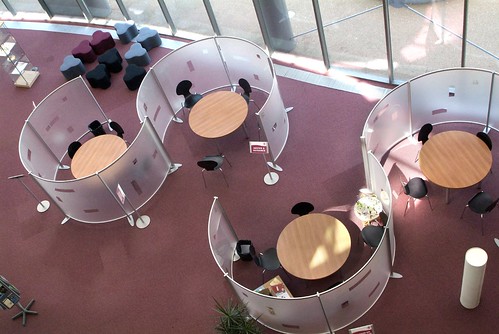Designing 21st Century Conference Learning Experiences And Spaces
Our conference learning spaces affect our audience.
We must learn to think like designers. Then we can focus on changing our conference participants’ learning spaces with the right goal in mind—nurturing their learning.
Be forewarned! We are not decorating learning spaces. We are designing them to foster, nurture and amplify our participants’ learning. (Hat tips Rebecca Louise Hare and Dr. Robert Dillon authors of The Space: A Guide for Educators.)
Are You Putting Lipstick On Outdated Conference Education Models And Calling It A Success?
Too many conference organizers think that they are creating new learning experiences by using new room sets, different furniture or unusual staging and lighting. However, that will not foster learning if you don’t change the learning experience.
You can’t just change the cosmetics-which will get a temporary emotional wow from the audience–and expect it will change their attitudes, behaviors and skills. It won’t. You’ve just put lipstick on your outdated, transactional, informational delivery methods.
You need to do both! Change the experience first. Then change the learning space to accommodate the goal of that learning experience.
Think About These As You Plan And Design
Here are a few more questions to consider when changing your learning experiences and spaces:
1. Are your conference participants guests or collaborators?
Be careful. We often want to treat our customers as guests to host them. We need to move them to owning and participating in their learning. Not just passively consuming it. And we want to encourage them to own other’s learning experience too. We want them to become collaborators and co-creators, not passive guests just consuming an experience.
2. During your conference education sessions, are your participants stationary or free to move around the space to meet their needs?
This means we must design and plan an entirely new learning experience. We need to move away from passive listening to expert lectures or panel dialogues. We have to rethink what we’re currently doing. (You don’t have to change everything. Start with changing twenty percent of your sessions.) Regardless, we must get our attendees up and moving and not sitting for sixty-, seventy-five-, ninety-minutes or event eight hours a day. We need to encourage them to experience learning in jumbled formats not just a passive linear progression. (More on jumbled formats coming soon!) Remember, in learning, motion helps recall and understanding.
3. Do today’s participants have different expectations for their learning experiences?
If you asked them, would they even know how they learn and which learning experiences and spaces best serve their needs?
Sometimes they just want things to be like they always have been done. If you ask them, they may tell you no, don’t change! Their brains want to avoid work. And learning is work. This is where you’ve got to help them understand that they need to do the opposite of what their brain wants to do so they can have deep, authentic learning. Help them embrace and adopt meta-cognition.
The Best And Biggest Question To Ask During Your Conference Planning Process
Above all, start your conference design with this major question:
Do our conference venue spaces serve as learning spaces? And if not, how can we transform both our learning experiences and spaces to create deep learning?
Remember, your conference participants deserve life-giving transformational learning experiences. And that requires transformational learning spaces that foster dialogue, collaboration and co-creation.
What strikes you the most with these questions about conference learning experiences and learning spaces? What questions would you add to this list?



I like this article a lot. Thank you. I think that moving around the training space would add a lot to the experience of learning. I always was the “wiggly” kid at school or the university that could not sit still. If I could move around – with a learning goal in mind, it would help like crazy.
Also, adding some of the newer audience-centric even engagement and response technology will enable the participants to be collaborators. We have seen up to 900% lift of audience engagement when our partners used Tap To Speak, the new Q&A and feedback engagement app.
“Collaborators not participants” – I like that.